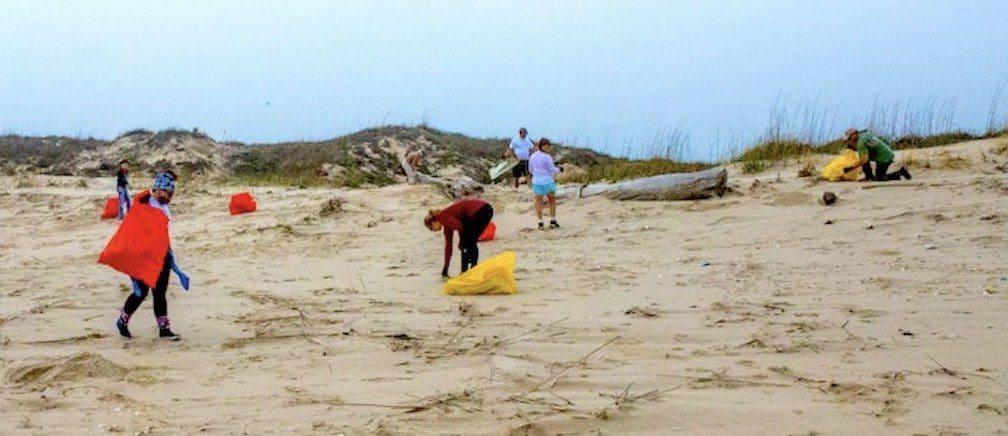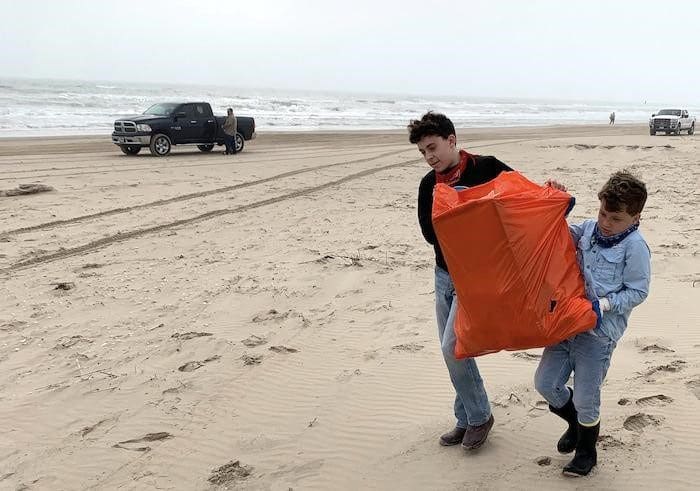
For the Locals, Protecting Padre Island National Seashore is Personal


By Barbara Jensen
Don’t miss the signs leading you toPadre Island National Seashore. It’s not well-marked until you’re right out on it—out where the trucks and jeeps leave tracks on the hard-packed sand. Only a half-hour from Corpus Christi, Texas, this national park’s south beach extends 60 miles from the end of the paved road, a four-wheel-drive access to wilderness encompassing Little Shell and Big Shell beaches. Deer and coyotes roam the rugged dunes.
This is definitely not South Padre Island, the spring break destination near Brownsville. Though they’re both on the same 118-mile-long barrier island, the national seashore is not a beach party resort. Out here, there is a community that believes in caring for its local national park.
Hiking with my full backpack along the edge of the water, I dodge the occasional wave reaching farther ashore. More than one truck stops to ask good-naturedly if I’m heading to Mexico. I’m sure it looks like I’m running away from it all, having left my car and any creature comforts at the last parking area. One couple surf-fishing calls me over to their RV and hands me a bologna sandwich and potato chips. A mile farther down the beach, two guys watching their lines from the comfort of their camp chairs offer me a cold refreshment from their cooler. Everybody waves.
It is precisely this spirit of camaraderie that has brought me back after my initial stopover.
On my first trip just two weeks prior, high-tide warnings had been posted. Assured by a ranger that my beach camping plan was still viable, I had hiked about four miles down the shore and then set down my pack. But I’d felt slightly uneasy, worried I might be pitching my tent too close to the rising waves. I’d shouldered my pack again and walked another few yards to a higher, more protected spot by the dunes.
When I unzipped my tent the next morning, everything was shrouded in fog. Peering out, I had to look twice.

To my right, I surprised the pint-sized resident of a nearby sandy burrow as it simultaneously popped out from its entrance: a ghost crab nearly invisible on the sand.
Then I looked to my left. And there, only a few yards up the beach, rising out of the mist, I spied a ghostship.A sailboat, at least 30-feet-long with an even taller empty mast, solidly beached. It was at that moment that I did a double-take.
It had run aground in the night, apparently without a soul on board. No tracks led away in any direction. The boat had come ashore at the exact spot I had initially thought to camp.
I felt the hairs on my neck stand up. What were the odds of this unlikely coincidence? As I waded in the surf to take a closer peek, I saw black spray paint on the boat noting “USCG” and “OK” with a date from several days ago. Had this boat been boarded at sea by the Coast Guard? And somehow deemed okay? The shredded sail hanging from the rigging and the scraped gash near the hull’s waterline at the bow did not look okay to me. One window of the glassed-in pilothouse was propped open like an escape hatch. I wondered if the Coast Guard would tow it to shore.A fisherman I met later just laughed, joking that they probably hoped it would sink.
Instead, it became the biggest piece of discarded refuse to wash up on Padre Island National Seashore in years. And that’s saying something. Because this place collects all kinds of castoffs. The winds and currents of the Gulf of Mexico join forces near Padre to deposit odd shoes and ends of rope, closet hangers and cell phone cases, the flotsam and jetsam of our daily lives all washing up with the tides. I’d noticed the trash on the beach as I hiked, the weird similarities of a crushed can to a chipped shell, a plastic grocery bag to a dying jellyfish, a waterlogged scrap of carpet to a thick mat of seaweed. But nothing I’d seen compared to finding a boat outside my tent.
When I’d left that day, I’d chatted with a park ranger about everything that washes ashore here, what he called the catcher’s mitt effect. “Oh, well, what can you do?,” I said.
Veteran adrift embraces the island
“Actually, there’s a clean-up day coming up, if you want to come back for that,” he told me. “It’s pretty amazing, all the people who participate. The Billy Sandifer Annual Beach Clean-Up.”
Billy Sandifer showed up on Padre Island after two tours of duty in Vietnam and a couple more at Guantanamo Bay, Cuba. A former Navy man now rudderless, he lived wild on the beaches from the summer of 1977 to February 1979. In a 2009 interview with the Corpus ChristiCaller-Times, Sandifer explained, “I was just a misfit without a mission. Shark fishing became my war. And at the time I needed a war. I needed an enemy.”

Gradually, Padre Island had a healing effect on Sandifer, allowing him to let go of war and embrace the people he met there. His shark fishing evolved to include conservation tours to promote protection for sea turtles, migratory birds, and other local flora and fauna, especially his “dune dogs,” the coyotes with whom he felt a spiritual kinship. He developed a deep reverence for mother ocean, as he called it, and the island itself. In 1995, he started the annual Big Shell Beach Clean-up as a way to give back, always hoping to engage the next generation in island ecology. By the time of his death in 2018 at age 70, Captain Billy, the rough-edged, cigar-smoking “Padre of Padre,” had received numerous conservation awards and had found peace at last.
“He was hardcore for a long time, but the beach really helped him,” said Jeff Wolda, who is the treasurer ofFriends of Padre, a nonprofit group whose mission is to continue Captain Billy’s legacy, preserving and protecting wild Padre Island. “Billy was like a father to a lot of us.”
Wolda is also a military veteran who, 20 years after Sandifer, found Padre Island National Seashore by chance—or by providence. Wolda, too, camped far down the beach, alone, in all seasons, so often that he learned to recognize the sound of Sandifer’s beaten up, rusted out Suburban passing on the sand, not realizing that Sandifer had come to recognize Wolda, too.
While Padre Island National Seashore has remained undeveloped for most of its entire existence, the first permanent settlement was established around 1804 by a Spanish priest, Padre Nicolas Balli. Balli created a ranch that raised herds of cattle, sheep, and horses with his nephew, but they never lived there themselves.
Out surf-fishing one nasty winter day, Wolda was trying to reel in a sea trout when he heard the Suburban pull up behind him. He didn’t want to bring in his fish and thereby invite another fisherman to his spot. “Billy stepped out of the vehicle and walked up behind me,” Wolda says, “asking me, ‘You gonna land that fish?’—well, it got pretty salty.” When Wolda caught and then released the big trout in front of him, something in that moment confirmed Sandifer’s hunch.
“Billy said, ‘You’re ex-military,’ and brought me his business card from the Suburban,” said Wolda. “‘Next time you come back to Padre, come see me. We need to talk.’ He helped me through some hard times. He helped a lot of guys.” It was Wolda who got the charter to guide light-tackle fishing at Padre Island when Sandifer retired in 2012.
Inspired by Captain Billy, I now find myself camped on the beach again. It’s the morning of the clean-up, and I’ve come back to help. I pack up my tent from overnighting at Mile Marker 20. I’ve definitely reached Little Shell Beach, small cockle shells crunching everywhere underfoot, but my destination is Big Shell, which starts farther south. To get there, I’m going to need a ride.
‘What can we give back?’
The sight of me in my backpack, holding a driftwood walking stick and standing at the water’s edge thumbing for a ride, seems to be a surprise even for Padre Island folk. One long caravan of four-by-fours and then another cruise right past.
But leading the third caravan, a red pickup stops for me. “You part of the beach clean-up?,” I said. After I clamber over the tailgate, he takes off, roaring through the looser, uneven sand down here.

My pack is heavy. I’m carrying plenty of fresh water in case I have to camp and hike back the whole distance to my car. By the time we stop at Mile 46, I’m facing a tough three-day return trip over bad terrain. But my driver, Brad Tabor, laughs and assures me he’ll give me a ride back. His wife, Elizabeth, and the two boys, Hudson, 14, and Finn, 8, all welcome me.
I have met the Friends of Padre. Trucks and jeeps park up and down the sand, and people of all ages and backgrounds gather. As section leader, Brad directs us to collect only garbage; anything natural, we leave. We spread out along the mile stretch we’ve been assigned.
It’s instant community. I watch the boys scrambling up the face of the dunes to grab faded detergent bottles and deflated mylar balloons. One guy hooks a tow strap to his truck and pulls an old tire loose from the sand as we all cheer. I help a woman with bad knees, gathering the trash near us so she can bag it. Everywhere I look, people are laughing and chatting, enjoying the day together. Over the course of just two hours, we load one guy’s huge construction trailer full of garbage bags.
“I’ve found all kinds of crazy stuff over the years,” said Wolda, “like a bottle with a note inside from a freighter off the coast of Norway. They asked us to write back and let them know where we found it. I asked Billy if he was going to write back. He said, ‘Yeah, I’m gonna tell ‘em to quit throwin’ stuff in the ocean.’”
When asked why he joined Friends of Padre back in 2001, his response was immediate. “Billy asked me to.” He started as a section leader, like Brad. The reason he continues his commitment is equally simple. “We use the island. What can we give back? You know, a lot of work goes into getting ready for the clean-up. We’re at Mother Nature’s mercy each year, rain or shine, and I always worry if no one shows up. And every year, as I’m setting up, I’ll look north and there’s headlights as far as you can see heading this way. Here they come.”
On that day, 1,000 volunteers have collected more than 33 tons of garbage from 27 miles of Big Shell and beyond. That brings the grand total to 12,425 volunteers over the years, cleaning up over 3 million pounds of trash. A labor of love started by one feisty guy—one of war’s castoffs who found himself here on Padre Island National Seashore.
When we’re done, I climb into the back of Brad’s truck. Mile after mile, we drive down the pristine beach, and I look out over the Gulf, the wind in my face. Maybe Captain Billy sent me a boat to bring me back here to make this personal connection with Padre Island. I can’t help but grin as I think, he really ought to quit throwing stuffinto the ocean.



